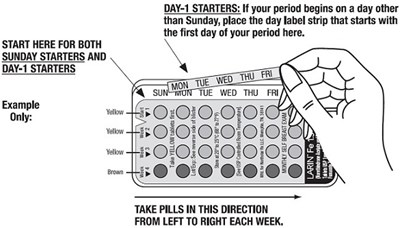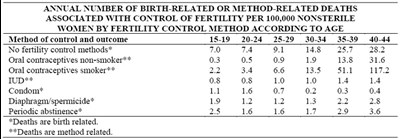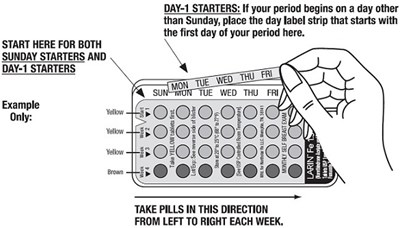Product Images Larin Fe 1.5/30
View Photos of Packaging, Labels & Appearance
Product Label Images
The following 13 images provide visual information about the product associated with Larin Fe 1.5/30 NDC 16714-405 by Northstar Rx Llc, such as packaging, labeling, and the appearance of the drug itself. This resource could be helpful for medical professionals, pharmacists, and patients seeking to verify medication information and ensure they have the correct product.
2 - image 02

This table shows the lowest expected and typical failure rates during the first year of continuous use of various contraceptive methods. The failure rates range from less than 1% to 26%, with oral contraceptives having the lowest failure rates, while spermicides alone, vaginal sponges, and periodic abstinence have higher failure rates. The data is adapted from a reference and represents the best estimates of the percentage of women expected to experience an accidental pregnancy among couples who initiate a method and use it consistently and correctly during the first year if they do not stop for any other reason.*
3 - image 03
Cigarette smoking is strongly discouraged for women who use oral contraceptives due to the increased risk of serious cardiovascular side effects. This risk becomes more severe with age and heavy smoking, especially for women over 35 years old. Therefore, it is highly recommended that women using oral contraceptives avoid smoking altogether.*
4 - image 04

The text presents a table I that shows the mortality rates per 100,000 woman years categorized by age, smoking status, and oral contraceptive use for circulatory disease. However, no specific values are available.*
5 - image 05

This is a table showing the annual number of birth or method-related deaths associated with fertility control methods per 100,000 nonsterile women by age. The table includes data for various methods including no fertility control methods, oral contraceptives for smokers and non-smokers, the intrauterine device, condom, diaphragm/spermicide, and periodic abstinence. The data show the number of deaths per 100,000 women in different age groups (15-19, 20-24, 25-29, 30-34, and 40-44) for each method. The deaths are identified as birth-related or method-related. The information is adapted from H.W. Ory, Reference 41.*
6 - image 06
Cigarette smoking can lead to significant cardiovascular health problems when used alongside oral contraceptives, particularly in women over 35 and those who smoke heavily (15 or more cigarettes a day). Women taking oral contraceptives are strongly advised to avoid smoking to reduce these risks.*
7 - image 07

This is a set of instructions for women who use birth control pills. The text provides guidance on how to begin the pill pack if the menstrual cycle starts on a day other than Sunday. The user has to place the label strip with the day of their menstruation in the correct position. The general instructions direct users to start taking pills from left to right each week.*
8 - image 08
Cigarette smoking and oral contraceptive use can result in serious cardiovascular side effects. The risks are higher in women over the age of 35 and those who smoke 15 or more cigarettes a day. To mitigate the risks, women taking oral contraceptives are strongly urged not to smoke.*
9 - image 09
Cigarette smoking can increase the risk of cardiovascular side effects when taking oral contraceptives. The risk is higher with age and heavy smoking of 15 or more cigarettes per day, especially for women over 35 years old. It is strongly recommended for women using oral contraceptives to avoid smoking.*
10 - image 10

This text presents tables showing the annual number of birth-related or method-related deaths associated with control of fertility per 100,000 nonsterile women by fertility control method according to age. It shows the mortality rate for different age groups and methods such as no fertility control, oral contraceptives for smokers and non-smokers, TUD, condoms, diaphragm/spermicide, and periodic abstinence. The data is presented separately for birth-related and method-related deaths.*
11 - image 11

This is a set of instructions to follow while taking birth control pills. It explains how to start taking the pills on either Sunday or the first day of your period. It includes a strip with day labels to keep track of when to take the pills each week. It directs to take the pills in a specific direction from left to right each week.*
* The product label images have been analyzed using a combination of traditional computing and machine learning techniques. It should be noted that the descriptions provided may not be entirely accurate as they are experimental in nature. Use the information in this page at your own discretion and risk.


